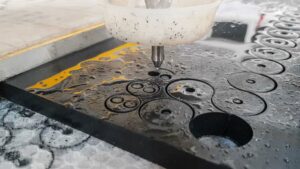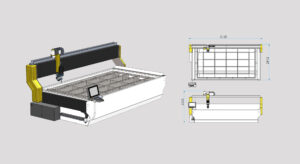Waterjet cutters are not complex machinery, even though they are good at cutting. However, to get the best experience using a waterjet machine for cutting, you need to understand the technicalities.
Additionally, to get high-quality cuts and to make the cutter last longer, you need to know about the working limits of your water jet machine.
One of the things to know beforehand is about the upper thickness limit that a waterjet cutter can handle.
Here, you will get all the information about the maximum thickness of materials you can cut using a waterjet cutting machine. You will also find a side-by-side comparison of the upper thickness limit for various cutting alternatives.
Factors that Influence a Waterjet’s Upper Thickness Limit
Before we look at waterjet cutting different materials, here’s an overview of several factors that govern cutting ability.
Thick Materials and Hardness
Thickness and material hardness are the most critical factors in water jet cutting. Thick materials involve more force to cut than thinner materials. Soft materials allow for a deeper cut than hard materials. The hardness is determined by the density of the material.
Duration
The time needed by the water jet cutter to cut through the workpiece also influences how thick the material can be for a successful cut. A longer cutting duration means thick materials can be cut easily.
How Thick Can Waterjet Cut?
How thick the material is you cut with a waterjet machine depends on the waterjet cutting method you use. There are two types of waterjet cutting processes: abrasive waterjet and pure waterjet cutting.
Let’s see how these two waterjet cutting methods handle some common types of materials.
Abrasive Waterjet Cutting
In normal conditions, an abrasive waterjet machine can cut through 12 inches (30 cm) of most materials such as stainless steel and carbon steel. Advanced abrasive waterjets using garnet particles can cut more than that.
Pure Waterjet Cutting
Pure water jet cutting can handle thick foam, rubber, and paper as you require. Even foam and paper a few feet thick are no big deal for a pure waterjet cutter.
However, when cutting harder substances, it becomes a problem to use pure waterjet cutting. Therefore, advanced water jets using abrasive waterjet cutting technology are preferred for thicker materials.
Cutting Thickness for Soft Materials
Waterjet cutters are used to cut soft materials like 2-3 feet thick foam. In addition to other benefits of waterjet cutting, softer materials also allow a smooth cut edge and near-net-shape fabrication applications with minimal finishing required. Water jet cutting is extensively used in the paper industry to cut thick reams of paper.
Cutting Thickness for Hard Materials
Abrasive water jet cutting is the preferred method for handling hard materials like titanium, stainless steel, aluminum, and virtually anything except for diamonds. Waterjet cutters can make cuts of between 25-30 cm (10-12 inches) in hard materials.
It is possible to cut thicker material, but it reduces cutting speed. If you have a lot of time on your hands, there is no limit to the material you can cut with a water jet cutter.
How thick can a water jet cut steel?
Waterjet cutters can cut through 9 inches of stainless steel. Anything thicker increases the cutting time significantly. Some applications reconfigure waterjet systems to cut through even 18-inch steel blocks.
However, in many applications waterjet cutters are utilized to cut 4-inch steel. In these applications, waterjet cutting is both fast and cost-effective.
How thick can a water jet cut aluminum?
Abrasive water jet cutters can cut through aluminum very easily. In fact, you can cut an 8-inch thick block of aluminum in a single pass.
What are the Benefits of Cutting a Thick Material with a Waterjet Cutter?
When you are cutting thick material with waterjet cutters, you get many benefits that other alternatives might not provide:
Superior Edge Quality
Waterjet cutting provides a superior edge quality that is unmatchable by any other processes. This is because waterjet cutting is a no-contact method, and there is no temperature rise in the cut edge. Therefore, no material distortion occurs even when cutting thick materials, leading to a smooth finish.
Range of Materials
With waterjet cutting, you are not limited to cutting thick metals. You can even cut thick foam, rubber, leather, paper, glass, plastics, wood, and composites. This makes a waterjet cutter very versatile machinery. Abrasive waterjet cutting can easily cut brass, tool steel, and even stone such as granite and marble.
No Heat-Affected Zone
When using other techniques for cutting thick materials, heat-affected zones form at the cutting edge. Additionally, cutting thicker materials leads to a higher temperature rise and much material distortion. Waterjet cutting involves no such phenomenon.
Tolerances
Due to higher distortion caused by alternative cutting techniques, it is more challenging to maintain tight accuracies or cutting tolerances. However, since waterjet cutting is a cold cutting process, it creates cuts with tight accuracies in even thicker materials.
Cutting Thickness of Waterjet Compared to Other Types of Cutting
Knowing the details about water jet cutting for thicker materials will not be enough unless you know how the alternatives perform in the same conditions.
Therefore, here is a brief comparison of water jet cutting against other cutting methods:
Water Jet vs EDM Cutting
Electrical Discharge Machining (EDM) cutting applies only to the cutting of electrically conductive material. It has a maximum cutting limit of 8 inches. Therefore, it lacks cutting depth and does not support the range of materials that waterjet cutting does.
Water Jet vs Plasma Cutting
Plasma cutters can only cut materials up to one inch thick. This is just a fraction of what waterjets are capable of. Just like EDM cutting, plasma cutting has limits when cutting thicker materials.
Water Jet vs Laser Cutting
Laser cutters are also very limited when it comes to cutting thicker materials. Lasers can cut mild steel up to 1.25 inches thick. Laser cutters can cut diverse materials like waterjet cutters, including wood and ceramics. However, when cutting thicker materials, waterjet cutters win the battle.
For more in-depth comparisons check our dedicated pages:
Endnotes
Abrasive waterjet cutting is the most popular cutting technology used nowadays, whether you consider small-scale fabricators or large-scale manufacturers.
The huge popularity of waterjet machines, especially abrasive water jets is not without cause. As you have read in this article, waterjet cutting is extensively used to cut thin and thick materials. These might be a fraction of an inch of foam or thick steel and titanium blocks more than 12 inches thick.
If you feel your next project could use technology like water jet cutting, check out the range of products available at Techni Waterjet. Techni Waterjet offers industry-leading waterjet machines suitable for cutting materials for various applications, so they will be a perfect fit for you.
In case you have any doubts regarding waterjet cutting technology or which products will be perfect for your needs, you can reach out to Techni Waterjet. Our team of experts is waiting to answer your questions.





